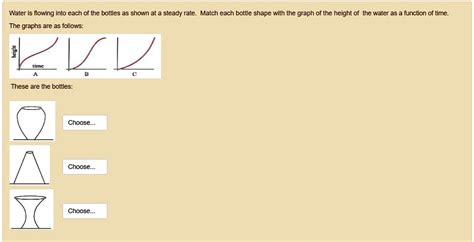explain the differences in the graphs of bottle a and b|MODULE SOLAR ENERGY AND THE ATMOSPHERE : Bacolod When asked to describe patterns in graphs, you ‘say what you see’. To describe the graph in Figure 1, for example, you could say: “The rate of photosynthesis . Tingnan ang higit pa Watch GirlsDoPorn pornstar fucked big cock video GDP E537 (49 min), uploaded by ChantalsCarol Category: Point of View , Big Cock , Cowgirl , Pornstar , Gagging

explain the differences in the graphs of bottle a and b,When asked to explain graphs, you give reasons for each trend in the bars or lines on the graph. Aim to use the word “because”. In Figure 1, the rate of photosynthesis increases when temperature increases because temperature increases the kinetic energy store of the enzyme and substrate molecules . Tingnan ang higit pa
When asked to describe patterns in graphs, you ‘say what you see’. To describe the graph in Figure 1, for example, you could say: “The rate of photosynthesis . Tingnan ang higit paIn questions where you are asked to compare, you need to comment on both the similarities and differences. For example, to compare the graph in Figure 1 with the graph in Figure 2you would say that as . Tingnan ang higit paexplain the differences in the graphs of bottle a and b MODULE SOLAR ENERGY AND THE ATMOSPHERE In questions where you are asked to compare, you need to comment on both the similarities and differences. For example, to compare the graph in Figure 1 with the graph in Figure 2you would say that as . Tingnan ang higit pa

A line of best fit helps to illustrate relationships between two variables that are continuous. A straight line of best fit shows us . Tingnan ang higit pa
explain the differences in the graphs of bottle a and bA line graph can reveal a correlation between two variables, but it cannot distinguish between causation and coincidence. . Tingnan ang higit pagraphs differ. If you project the investigation onto the whiteboard, you can simply sketch the new graph over the original graph in #1. Be sure also to note any differences in the .Since we were able to determine that Graph B 1 and Graph B 2 have no obvious differences, and they are relatively small graphs, we will attempt to transform one . Figure 15.6.3: The Titration of (a) a Weak Acid with a Strong Base and (b) a Weak Base with a Strong Acid. (a) As 0.200 M NaOH is slowly added to 50.0 mL of .
We can state Charles’s and Gay-Lussac’s findings in simple terms: At constant pressure, the volume of a fixed amount of gas is directly proportional to its .
Q5. Describe the graph resulting from observations in Bottle A. Q6. Describe the graph resulting from observations in Bottle B. Q7. Explain the similarities in the graphs of .

Bottles and Graphs Match each bottle below to the correct graph of depth plotted against time when the bottle is filled with water at a constant rate. Sketch bottle F which .Graph labels and scales. Google Classroom. Sean drank a slushy as fast as he could. He modeled the relationship between the time since he started drinking T (in seconds) and the remaining amount of slushy S (in milliliters) as S = 600 − 7.5 T . He wanted to graph .
explain the differences in the graphs of bottle a and b|MODULE SOLAR ENERGY AND THE ATMOSPHERE
PH0 · MODULE SOLAR ENERGY AND THE ATMOSPHERE
PH1 · Interpreting graphs
PH2 · Instructor Notes for Module 5
PH3 · Graph labels and scales (practice)
PH4 · Filling Bottles
PH5 · Describing, explaining and comparing graphs
PH6 · Bottles and Graphs A B C D E F 1 2 3 4 5 6
PH7 · 5.3: The Simple Gas Laws
PH8 · 15.6: Acid
PH9 · 12.4: Comparing Graphs